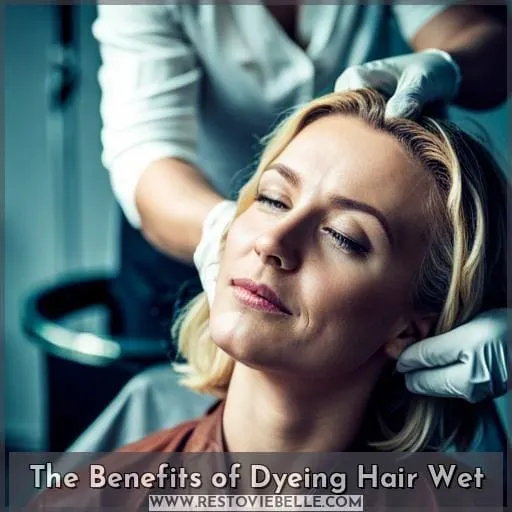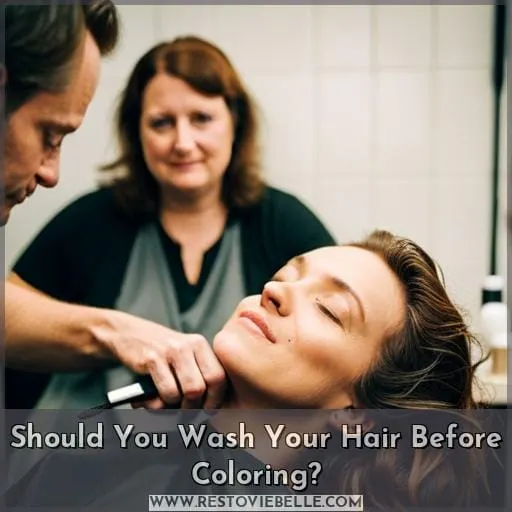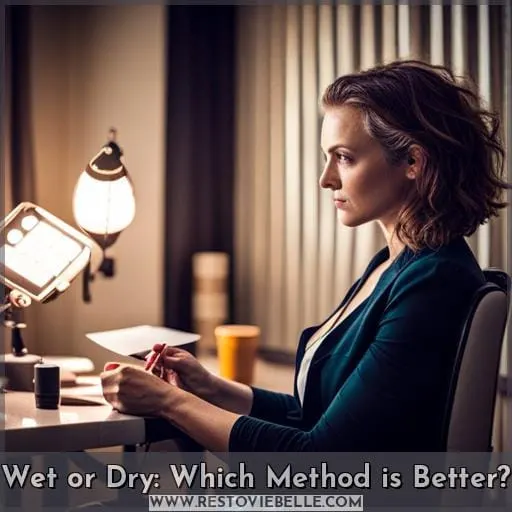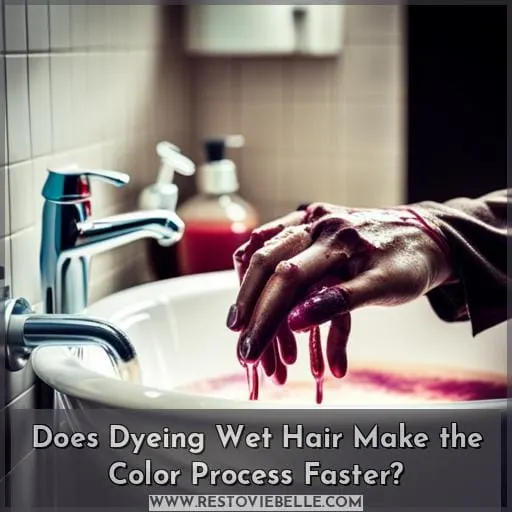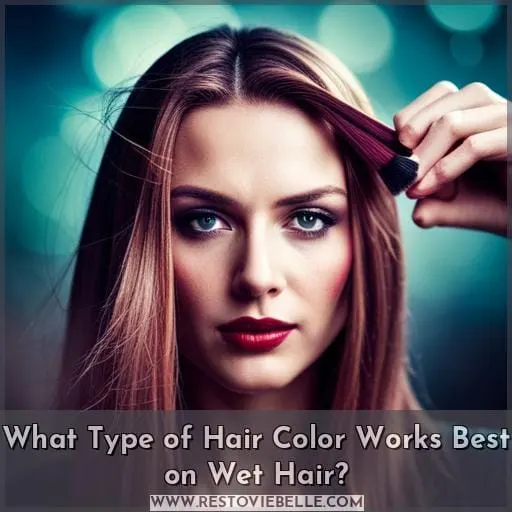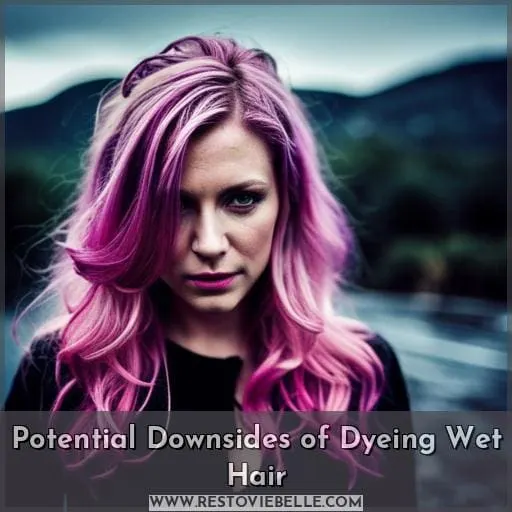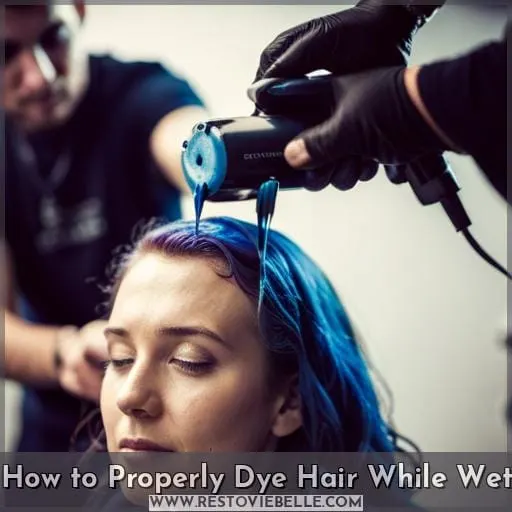This site is supported by our readers. We may earn a commission, at no cost to you, if you purchase through links.
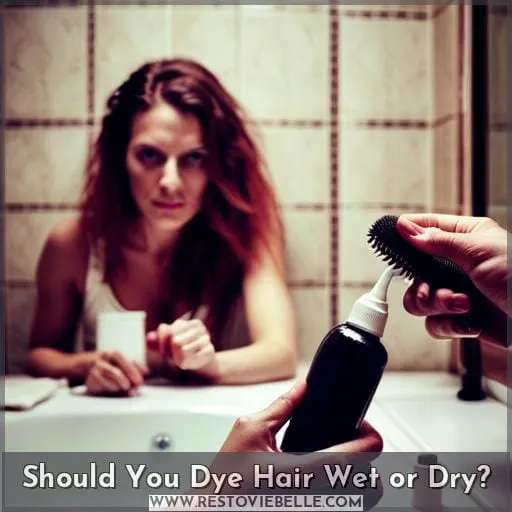 Ready for a hair transformation? Discover the best way to dye your hair – wet or dry? It’s like choosing between bold and subtle, vibrant and natural. We’ll break down the pros and cons of each method so you can make an informed decision.
Ready for a hair transformation? Discover the best way to dye your hair – wet or dry? It’s like choosing between bold and subtle, vibrant and natural. We’ll break down the pros and cons of each method so you can make an informed decision.
Find out if wet or dry is better for your desired result, how it affects color distribution, and what type of hair texture works best with each approach.
Get ready to take control of your next dye job!
Table Of Contents
- Key Takeaways
- The Benefits of Dyeing Hair Wet
- Should You Wash Your Hair Before Coloring?
- Wet or Dry: Which Method is Better?
- Does Dyeing Wet Hair Make the Color Process Faster?
- What Type of Hair Color Works Best on Wet Hair?
- Potential Downsides of Dyeing Wet Hair
- How to Properly Dye Hair While Wet
- Recommended Products for Dyeing Wet Hai
- Frequently Asked Questions (FAQs)
- Conclusion
Key Takeaways
- Dyeing hair wet can result in more vibrant and long-lasting color.
- Wet hair allows for faster and deeper color penetration.
- Temporary hair colors like demi-permanent or semi-permanent dyes work best on wet hair.
- Dyeing wet hair may lead to uneven color application and dilution of color.
The Benefits of Dyeing Hair Wet
When dyeing your hair wet, there are several benefits to consider.
Firstly, it can result in a more subtle color outcome, which is ideal for those who prefer a softer change.
Additionally, the water present in wet hair helps distribute the color more evenly throughout the strands and requires less dye overall.
Lastly, this method tends to work well for individuals with coarse or thick hair textures as it allows for better absorption of the color.
Subtle Result
When dyeing your hair wet, you can achieve a more subtle result due to the compound preposition of water being able to distribute the color better.
Benefits include:
- Less processing
- Less damage
- More natural results
- Easier application
- Saving time
Better Color Distribution
To achieve better color distribution, dyeing your hair while it’s wet can be beneficial.
The water helps distribute the color more evenly and allows for better coverage. This means less dye is needed, resulting in a more subtle result and reducing potential damage to your hair.
Less Dye Needed
You’ll need less dye when coloring your hair wet.
Wet hair allows for better color distribution, resulting in a more vibrant and even color.
Additionally, the moisture helps to dilute the dye, making application easier and reducing potential damage to your hair.
Adds Dimension
Dyeing your hair while it’s wet can add subtle dimension to your locks.
The moisture in wet hair helps the color distribute more evenly for a natural and vibrant result.
It also requires less harsh processing, reducing damage.
Works Well for Coarse or Thick Hair Texture
If you have coarse or thick hair, dyeing it while wet can often yield better results.
Wet hair allows for easier application and more control over the color distribution.
This method can result in less damage and more vibrant, better-looking results.
Should You Wash Your Hair Before Coloring?
Before coloring your hair, it’s best to skip shampooing directly before the coloring session.
When you wash your hair right before applying color, you strip away natural oils and moisture that can help protect your strands during the dyeing process. Cleanse your locks with shampoo a day or two prior to coloring to ensure a clean canvas without compromising the health of your hair.
When it comes to wet or dry application, there’s no hard and fast rule for washing beforehand. However, if you choose wet application for semi-permanent or demi-permanent dyes, make sure not to apply them on freshly washed wet strands as excess water may dilute their effectiveness.
Ultimately, whether you decide on wet or dry application depends on personal preference and the type of color product being used. Just remember that permanent colors require dry application due in part because they need direct contact with undiluted pigment molecules in order achieve optimal results while minimizing potential damage.
Wet or Dry: Which Method is Better?
When deciding between dyeing your hair wet or dry, it’s important to consider which method yields better results.
The main factor that determines the effectiveness of each method is color absorption. When your hair is wet, the hair cuticle opens up, allowing for faster and deeper color penetration. This means that dyeing your hair while wet can result in more vibrant and long-lasting color.
However, there are certain drawbacks to dyeing wet hair as well. Wet hair tends to be more fragile and prone to damage compared to dry hair. Additionally, applying dye on damp strands can lead to uneven application and dilution of the color.
In terms of technique, professional salons often prefer dry application because it allows for greater control over the process and ensures even distribution of color throughout the entire head.
Ultimately, whether you choose a salon or at-home coloring session depends on various factors such as desired outcome, expertise level in handling chemicals safely at home vs professional guidance available at a salon setting among others; so weigh these considerations before making a decision about whether you should opt for dying your locks when they’re moistened with water or completely dried out beforehand during any future beauty endeavors!
Does Dyeing Wet Hair Make the Color Process Faster?
Dyeing wet hair can indeed make the color process faster.
When your hair is wet, the cuticle of each strand is more open, allowing the dye to penetrate and absorb more quickly compared to dry hair.
While dyeing wet hair may speed up the process, it can result in a less vibrant color because water acts as a diluting agent for dyes.
Additionally, applying dye to wet hair in the shower or using other shower dyes can lead to uneven color application since it’s harder to see where you’ve already applied product on damp strands.
If you’re looking for quick results and don’t mind sacrificing vibrancy for convenience or prefer a softer look with slightly muted tones, then dyeing your hair while wet could be an option worth exploring.
Just keep in mind that achieving bold and intense colors may require dry application methods instead.
What Type of Hair Color Works Best on Wet Hair?
For best results when dyeing your hair wet, opt for temporary hair colors such as demi-permanent or semi-permanent dyes.
These types of hair color work well on wet hair because they don’t contain ammonia and are specifically designed to deposit color onto the strands. Demi-permanent and semi-permanent dyes provide a temporary change in color without causing significant damage to the hair.
They can be applied easily on damp or wet locks, ensuring better distribution of the product throughout the strands.
Demi-permanent dyes offer longer-lasting results compared to semi-permanents but still gradually fade over time. On the other hand, semi permanent dyes last even shorter periods but allow for more flexibility in experimenting with different shades without making a long-term commitment.
When applying these color options on wet hair, make sure to follow proper application techniques provided by each brand’s instructions for optimal outcomes while avoiding any potential risks associated with coloring damp tresses.
Potential Downsides of Dyeing Wet Hair
Dyeing your hair while it’s wet can come with potential downsides.
One of the main issues is that it can result in uneven color application, as the dye may not distribute evenly throughout damp hair.
Additionally, water acts as a diluting agent and could potentially lead to a less vibrant color outcome.
Lastly, wet hair is more fragile and prone to damage, so there’s an increased risk of causing harm to your strands during the dyeing process.
Uneven Color Application
To avoid uneven color application, it’s important to apply the dye evenly throughout wet hair.
When dyeing your hair while wet, there’s a risk that the color might be patchy or too dark in certain areas.
Additionally, wet hair may not hold onto the color as well as dry hair, causing it to fade faster over time.
Another downside is that the dye may bleed and stain surrounding areas during application.
Dilution of Color
When dyeing your hair while it’s wet, be cautious of the potential dilution of color due to water saturation.
Wet hair can cause the color intensity to diminish, resulting in a less vibrant outcome.
Additionally, excess water on the hair strands can lead to color transfer and faster fading over time.
To maintain optimal color absorption and longevity, consider dyeing your hair when it’s dry instead.
Increased Risk of Hair Damage
You may risk damaging your hair more if you dye it while wet.
Wet hair is more susceptible to breakage and damage due to its:
- Increased porosity
- Decreased elasticity
- Weakened strength
The water present in wet hair can dilute the color and make it less vibrant.
To maintain optimal hair health, it’s recommended to dye your hair when dry or seek professional guidance for wet dyeing techniques.
How to Properly Dye Hair While Wet
Now let’s delve into the process of dyeing your hair while it’s wet, so you can achieve the desired results with minimal damage.
- Shampoo your hair before applying the dye to ensure that it’s clean and ready for color application.
- Wring out any excess water from your hair before applying the dye.
- Put on gloves to protect your hands during the application process.
- Apply the dye evenly onto damp strands, making sure to cover all sections of your hair.
It’s important to note that when coloring wet hair, there are some drawbacks you should be aware of:
- The color won’t be as vibrant because water acts as a diluting agent for dyes.
- There’s a possibility of uneven color application due to variations in moisture levels throughout different areas of dampened strands.
By following these steps and being mindful about potential challenges, you can effectively apply color on wet hair and achieve satisfactory results without compromising its health or vibrancy
Recommended Products for Dyeing Wet Hai
To achieve the best results when dyeing hair while wet, it’s recommended to use products specifically designed for this method.
When coloring your hair while wet, you want to ensure that you’re using formulas that are suitable for damp or wet strands.
One option is to use demi-permanent or semi-permanent hair dyes. These types of dyes work well on wet hair because they don’t contain ammonia and can provide a more subtle color result.
In addition to traditional hair dyes, there are also other temporary options available such as color depositing masks and color shampoos.
Color depositing masks allow you to add temporary pigment while conditioning your locks at the same time.
On the other hand, color shampoos can help maintain vibrant hues by adding a touch of tint every time you wash your tresses.
When selecting products for dyeing wet hair, make sure to read their instructions carefully and follow them accordingly. This will ensure that you achieve optimal results without compromising the integrity of your strands.
Frequently Asked Questions (FAQs)
Can I dye my hair wet at home?
Yes, you can dye your hair wet at home.
However, it’s important to note that most at-home hair color kits aren’t designed for wet application.
For best results and minimizing damage, consult a professional hairstylist.
Will dyeing wet hair result in a more natural-looking color?
Dyeing your hair while wet can result in a more natural-looking color.
The moisture helps distribute the dye for subtle dimension, and less dye is needed.
However, it’s best to seek professional guidance to avoid damage or uneven application.
Is it necessary to wash my hair before using permanent hair dye?
To achieve optimal results with permanent hair dye, it’s recommended to apply it on dry, unwashed hair.
The natural oils in your hair help protect and nourish the strands during the coloring process for vibrant and long-lasting color.
Does dyeing wet hair require more or less product compared to dry hair?
When dyeing wet hair, you may need less product compared to dry hair.
The water in wet hair helps distribute the color more evenly, allowing for a subtle and dimensional result.
Achieve mastery over your desired look by choosing the right method for your needs.
What are the potential risks of dyeing hair while it’s wet?
Dyeing wet hair can be risky.
Like a treacherous path, it may lead to:
- Uneven color application
- diluted results
Your precious strands are more susceptible to damage in this vulnerable state.
Proceed with caution on this slippery journey.
Conclusion
To achieve your desired hair transformation, whether it’s a bold or subtle look, wet or dry hair dyeing methods have their own benefits and considerations.
Dyeing hair wet offers a more subtle result, better color distribution, and adds dimension. It works well for coarse or thick hair textures. However, there are potential downsides such as uneven color application and increased risk of hair damage.
Ultimately, the choice between wet or dry hair dyeing depends on your desired outcome and hair type.

